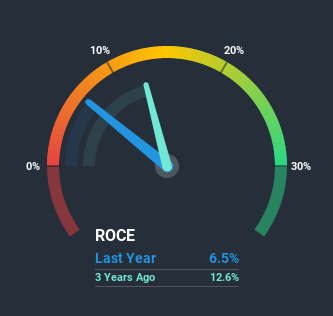The Returns On Capital At Banswara Syntex (NSE:BANSWRAS) Don't Inspire Confidence

What underlying fundamental trends can indicate that a company might be in decline? A business that's potentially in decline often shows two trends, a return on capital employed (ROCE) that's declining, and a base of capital employed that's also declining. Trends like this ultimately mean the business is reducing its investments and also earning less on what it has invested. In light of that, from a first glance at Banswara Syntex (NSE:BANSWRAS), we've spotted some signs that it could be struggling, so let's investigate.
What is Return On Capital Employed (ROCE)?
For those who don't know, ROCE is a measure of a company's yearly pre-tax profit (its return), relative to the capital employed in the business. Analysts use this formula to calculate it for Banswara Syntex:
Return on Capital Employed = Earnings Before Interest and Tax (EBIT) ÷ (Total Assets - Current Liabilities)
0.065 = ₹310m ÷ (₹7.7b - ₹2.9b) (Based on the trailing twelve months to September 2020).
Thus, Banswara Syntex has an ROCE of 6.5%. Ultimately, that's a low return and it under-performs the Luxury industry average of 8.7%.
View our latest analysis for Banswara Syntex

Historical performance is a great place to start when researching a stock so above you can see the gauge for Banswara Syntex's ROCE against it's prior returns. If you want to delve into the historical earnings, revenue and cash flow of Banswara Syntex, check out these free graphs here.
What The Trend Of ROCE Can Tell Us
We are a bit worried about the trend of returns on capital at Banswara Syntex. About five years ago, returns on capital were 15%, however they're now substantially lower than that as we saw above. And on the capital employed front, the business is utilizing roughly the same amount of capital as it was back then. Since returns are falling and the business has the same amount of assets employed, this can suggest it's a mature business that hasn't had much growth in the last five years. So because these trends aren't typically conducive to creating a multi-bagger, we wouldn't hold our breath on Banswara Syntex becoming one if things continue as they have.
On a related note, Banswara Syntex has decreased its current liabilities to 38% of total assets. That could partly explain why the ROCE has dropped. Effectively this means their suppliers or short-term creditors are funding less of the business, which reduces some elements of risk. Since the business is basically funding more of its operations with it's own money, you could argue this has made the business less efficient at generating ROCE.
The Bottom Line
In the end, the trend of lower returns on the same amount of capital isn't typically an indication that we're looking at a growth stock. Investors must expect better things on the horizon though because the stock has risen 13% in the last five years. Regardless, we don't like the trends as they are and if they persist, we think you might find better investments elsewhere.
Since virtually every company faces some risks, it's worth knowing what they are, and we've spotted 6 warning signs for Banswara Syntex (of which 1 shouldn't be ignored!) that you should know about.
While Banswara Syntex may not currently earn the highest returns, we've compiled a list of companies that currently earn more than 25% return on equity. Check out this free list here.
If you’re looking to trade Banswara Syntex, open an account with the lowest-cost* platform trusted by professionals, Interactive Brokers. Their clients from over 200 countries and territories trade stocks, options, futures, forex, bonds and funds worldwide from a single integrated account. Promoted
Valuation is complex, but we're here to simplify it.
Discover if Banswara Syntex might be undervalued or overvalued with our detailed analysis, featuring fair value estimates, potential risks, dividends, insider trades, and its financial condition.
Access Free AnalysisThis article by Simply Wall St is general in nature. It does not constitute a recommendation to buy or sell any stock, and does not take account of your objectives, or your financial situation. We aim to bring you long-term focused analysis driven by fundamental data. Note that our analysis may not factor in the latest price-sensitive company announcements or qualitative material. Simply Wall St has no position in any stocks mentioned.
*Interactive Brokers Rated Lowest Cost Broker by StockBrokers.com Annual Online Review 2020
Have feedback on this article? Concerned about the content? Get in touch with us directly. Alternatively, email editorial-team (at) simplywallst.com.
About NSEI:BANSWRAS
Banswara Syntex
Engages in the production and sale of textile products in India and internationally.
Slight with mediocre balance sheet.
Market Insights
Community Narratives



